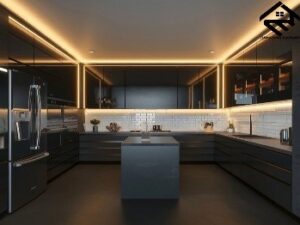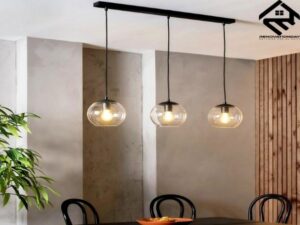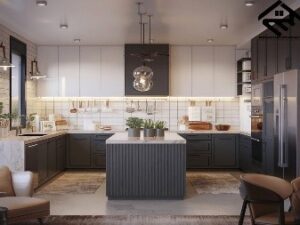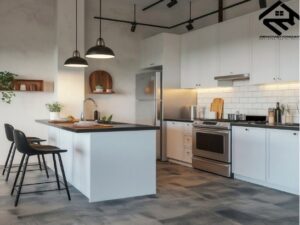The easiest way to give your kitchen a makeover is to try out some new lighting ideas. It’s all about finding the sweet spot between pretty and practical when it comes to kitchen lights. Let’s be honest, a ton of stuff happens in the kitchen. We spend ages picking out cabinets and appliances, but we often forget about the lighting. lighting often gets overlooked during renovations. Want to upgrade your kitchen without spending a fortune? Try some modern lighting ideas. It’s the easiest way to make a big difference. Here are a few tips to keep in mind.
A key for a dynamic and efficient kitchen
Proper lighting in the kitchen is more than providing lighting; This element directly affects the look, feel and function of your space. A good lighting not only helps you to cook easily, but also can create a warm and inviting atmosphere.
Proper Kitchen Illumination
Efficiency: Sufficient lighting is crucial for performing a range of culinary tasks. From food preparation to dishwashing, it provides the necessary illumination for accurate and swift execution.
Aesthetics: Lighting has a profound influence on the visual appeal of your kitchen. By strategically employing the right lighting techniques, you can effectively accentuate key elements such as the kitchen island, cabinetry, or decorative artwork.
Mood: Lighting can really change the vibe of your kitchen. Warm and cozy lights make it feel more inviting mood and, while bright, cool lights give it a modern and energetic feel. Modern home kitchen with cold and ice lighting that makes the place dynamic and minimal.
Types of kitchen lighting
General lighting: This type of lighting is used to illuminate the entire space and is usually provided by ceiling lights or recessed lights.
Task lighting: This lighting is used to illuminate certain areas of the kitchen, such as the counter, stove or sink, and is usually provided by under-cabinet lights or pendant lights.
Accent lighting: This lighting is used to highlight certain elements such as artwork, shelves or glass cabinets and is usually provided by spot lights or recessed lights.
LED strips: LED strips can be installed under cabinets, inside shelves or around the kitchen island to create beautiful indirect lighting.
Recessed lights: Recessed lights give the kitchen a clean and unified look and can be used as general lighting or task lighting.
Wall lights: Wall lights can be used as lighting and help create a focal point in the kitchen.
Lighting Your Kitchen: What to Do & What to Avoid
Figuring out the right lighting for your kitchen can be fun but also tricky. Here are some simple tips to help you out.
Uniform distribution of light
Dazzling suspended lights
Casual chandeliers
Add a Color Accent
On-trend designs
A touch of metal
Classic and retro
Uniform distribution of light
Ensure even lighting throughout to avoid annoying shadows. The combination of different types of light, you can use a combination of general, task and focus lights to create a dynamic and attractive atmosphere. Light control, use the dimming switches or dimmers to adjust the light intensity so that you can change the kitchen atmosphere according to your activity.
Dazzling suspended lights
Install dazzling drop lights to make your ceiling a real showstopper. You can try globe pendant lights with clear glass – they’ll make your kitchen feel bigger and brighter. The height of the lights affects the efficiency and beauty of the lighting. For example, pendant lights should be installed at the right height to provide enough light on the counter without causing distraction. Dazzling suspended lights, Can serve as a visual centerpiece in a kitchen and contribute to the establishment of a particular aesthetic.
For a warm glow all over, try hanging pendants with lots of bulbs that spread the light around. This kitchen lighting looks great – it has that cool industrial look with the gold hardware, but the white shade gives it a touch of glam.
Casual chandeliers
Want to add some beauty to your kitchen? Try installing a few simple chandeliers. A cage-style chandelier with clean lines would look great in a minimalist kitchen. You could also go for some wrought-iron chandeliers.
Add a Color Accent
Introduce a complementary color to enhance your transitional kitchen. Bold yellow pendants, inspired by the sun, offer both bright light and a cheerful pop of color.
On-trend designs
To cultivate an aesthetically captivating kitchen, consider integrating contemporary design trends, such as a modernized Hollywood Regency aesthetic. Elevate the space with opulent lighting fixtures, such as Restoration Hardware’s Boule de Cristal chandeliers.
A Touch of Metal
Add warmth to your kitchen with some metallic lighting. You could use warm bronze, cool silver, or shiny gold, depending on your kitchen’s style. Don’t forget to look for unique metallic fixtures!
Classic and retro
If your kitchen has a retro vibe, try mixing it up with modern things, like modern lighting. It’ll give you that cool vintage-meets-modern look. When you’re looking for lighting ideas, modern styles are exactly what you need.
Pay Attention to Scale
When selecting kitchen lighting, it is essential to consider the scale of the room. Statement lighting can appear overpowering in smaller spaces. An additional advantage of effective kitchen lighting is its capacity to visually expand the perceived spatial dimensions of the kitchen, creating an illusion of greater spaciousness. Consequently, one of the paramount challenges in designing small kitchens lies in the strategic utilization of lighting to engender a visual deception, thereby enhancing the perceived size of the space. With all this, If the dimensions of the kitchen are not given enough attention, in addition to excessive energy consumption, heat production, distraction and eye irritation may also happen.
Which part of the kitchen is decorative lighting?
Part of the kitchen lighting can be implemented in the ceiling. If there is enough space and the ceiling is high, hanging lights can be used. If the ceiling is short,
various and modern false ceiling designs with the use of hidden lights are more interesting nowadays.
Depending on the kitchen’s aesthetic, designers often emphasize unique illumination of the ceiling above the counter or island. This approach typically results in a more visually striking presentation.
Although it is possible to use pendants or decorative false ceilings with hidden lights to match the kitchen ceiling, another option is to utilize wall sconces. If the kitchen has an empty wall, you can employ wall sconces that complement the kitchen’s style. These sconces will be effective by reflecting light onto the wall or ceiling. Different spaces within the cabinets also provide suitable locations for implementing decorative kitchen lighting.
Lighting inside the kitchen cabinet
Perhaps you haven’t noticed, but every time you open the refrigerator door, the internal lighting illuminates the contents, allowing you to locate and access items more easily and quickly. Similarly, cabinet lighting functions in the same manner.
Although often overlooked, cabinet lighting plays a crucial role in enhancing comfort and ease during everyday kitchen tasks. Blind spots can occur within cabinets, where insufficient light may be available when the door is opened and only relying on the ambient kitchen lighting.
Cabinet lighting is particularly beneficial when cabinet interiors are dark or the kitchen itself is small. In these instances, interior cabinet lighting proves highly useful. The primary purpose of such lighting is to enhance visibility and contribute to a modern aesthetic.
Decorative lighting of the kitchen counter
The countertop serves as a pivotal element in both interior design and interior lighting schemes. Moreover, numerous daily and critical kitchen tasks are typically performed on the countertop. Therefore, the goal of countertop lighting is to ensure adequate illumination and achieve the desired lighting effect through the use of suitable fixtures. Moreover, the countertop typically commands greater visual attention than other areas of the kitchen.
Counter lighting, particularly the use of hidden lighting within false ceilings, creates stunning decorative effects in a variety of contemporary and modern designs.
Lighting above the kitchen sink
The sink is one of the areas in the kitchen where you often spend considerable time washing dishes, fruits, and other items. Adequate lighting at the sink is crucial. With sufficient illumination, you can wash more carefully.
Lighting in the sink is also done by hidden lights. And by reflecting the light in the sink, it gives you the confidence that everything there is under your supervision.
Kitchen ceiling lighting
Kitchens with high ceilings often utilize chandeliers. However, in modern architecture, false ceilings are commonly employed in kitchens, allowing for the installation of various types of hidden lighting. This approach ensures uniform and indirect illumination, creating a more tranquil and aesthetically pleasing kitchen environment. False ceilings can be constructed from diverse materials, feature a
variety of designs, and come in different colors to seamlessly integrate with the overall kitchen aesthetic.
False ceilings can be of different materials, different designs, and also different colors that match the general space of the kitchen. All kinds of built-in and surface lights can also be used on the ceiling.
Renovation Customize Your Kitchen
Combining contemporary and traditional kitchen lighting elements can result in a warm and energetic space. These modern lighting ideas allow you to
Personalize your kitchen. Install statement fixtures that brighten the space and enhance the design without exceeding your budget.
Perhaps you believe that installing a few lights and strings is a simple task that anyone can handle. However, emphasizes that proper kitchen lighting requires adherence to modern methods and techniques. This work necessitates the use of specialized tools and technologies. By implementing well-designed kitchen lighting, you can create a modern and aesthetically pleasing kitchen environment. Renovationday ensures you receive basic, modern lighting tailored specifically to your kitchen.
FAQs On Georgia Modern kitchen lights
How can I make my kitchen lights design without a major renovation?
The easiest way to renovation your kitchen lights on a budget is to update your fixtures, such as installing pendant lights and using smart lighting.
What is the cost of renovation kitchen lights?
While a kitchen lights will save you money in the long run, the cost of renovating kitchen lighting in Georgia, USA can range from $189 to $525 or more, depending on several.
Type of fixtures: Basic pendant lights might cost less than elaborate chandeliers or under-cabinet lighting systems.
Number of fixtures: More fixtures naturally increase the cost.
Labor costs: Electrician rates vary, and complex installations will take longer.
Smart lighting integration: Smart bulbs and controls add to the expense.
Additional electrical work: If rewiring is needed, it significantly increases the cost.
To get a more accurate estimate:
Consult with local electricians: Get quotes from several qualified professionals.
Consider your budget: Determine how much you’re willing to spend.
Choose fixtures wisely: Balance style with cost-effectiveness.
DIY vs. professional installation: Weigh the pros and cons of each option.
By carefully considering these factors, you can plan a kitchen lighting renovation that fits your budget and enhances your space.
And you can safely entrust all the matters to Renovationday professionals.
How can a kitchen lights improve energy efficiency?
By illuminating the entire kitchen surface, including previously neglected areas, we can enhance kitchen productivity. This integrated lighting approach minimizes distractions caused by inadequate lighting, poor color combinations, and the resulting excessive movement. Therefore, improve energy efficiency.
How is lighting done in kitchens that use windows in their design?
Given the diverse characteristics, quality, and physical properties of glass materials used in kitchen facades, lighting approaches for glass-fronted kitchens can vary significantly. Factors such as glass surface polish, light transmission and reflection properties influence the selection of lighting equipment and techniques, differentiating the lighting process for these kitchen styles.









